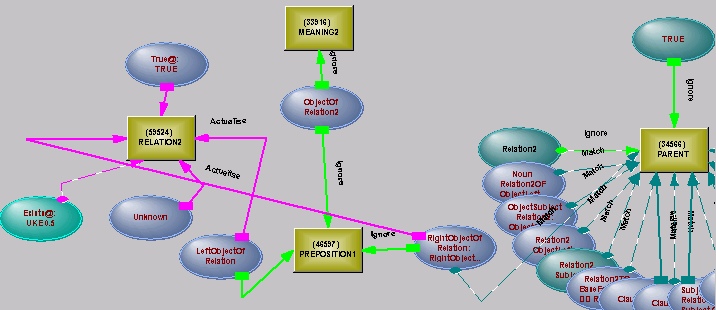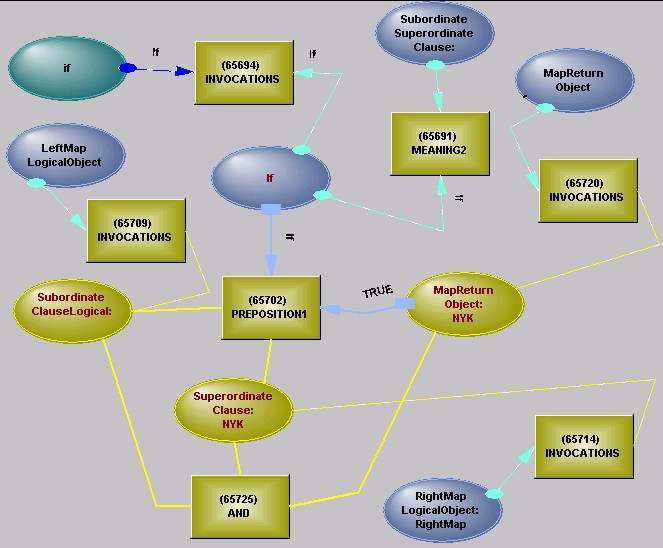
Active maps are used to implement the meaning of prepositions, to manipulate structure for collocations, and to connect multiple clauses in a compound sentence. The maps match and build structure, and are provided with the relevant parameters – the objects either side of a preposition, for instance.
The map first sets up a new level of hypothesising - if it fails, all its housekeeping, including any building, will be undone by backtracking. If it succeeds, it is cleaned ready for re-use.
The operations that active maps support are:
Operators within maps operate on objects rather than values - see Map Functions.
As soon as the map succeeds in matching and it builds the structure, the objects, states and values are pushed into (and out of) the new structure, which may cause switching, cutting of ranges or further building.
Example Preposition
Take "by" as an example
The house by the lake
– locationThe man was shot by the robber
– provides subject for passive verbHe was forced to run by the Mafia
– skips over an infinitive to connect to the subject of a causative verb ("...to run by the lake" would have been handled differently)An option exercisable by written notice
This is a little more complicated – only a person can exercise an option, so attempting to make "written notice" the subject of the ToExercise relation will fail. The "by" here is short for "by means of", or "using". So the fragment becomes
An unknown person can exercise the option by means of a written notice.
Use is one of the trickiest things a preposition does –
He cut the rope with a knife
is transformed into
He used a knife to cut the rope
Where ToUse is a three connection relation (a causative verb) –
Person ToUse Action
|
Used Thing
The prepositional mechanism is also used to handle noun phrases –
Business operations
Property asset
A map can include building a script joining the parameters and any newly constructed objects – the script can do things like adding an object to the dictionary or checking a clause reference or calculating a day number (a DateTime).
The number of different maps for each preposition needs to be kept to a minimum, as it is time consuming for the machine to go through them each time. "Of" may end up with fifty, "by" with ten, "under" with five. Many prepositions share maps – "of" and GermanPossessive, for instance.
Sample Maps
The noun phrase "Business Operations" is handled by
ObjectOfRelation

In this map, the right hand parameter is matched as a child of Relation2 (the PARENT operator on the right), then a relation structure (RELATION2 on the left of the diagram) is actualised, with the left hand parameter becoming the object of the relation. An Unknown is built as the subject of the relation.
Tenant’s business operations
The map for this (GermanPossessive) either actualises a relation, or inserts its left hand object as the subject of an existing relation. If the phrase had been
Tenant’s operations
the relation structure would not have been actualised yet.
Maps are arranged in sequence, with maps that will return true or false existence encountered first. In searching through maps, any that will return a true or false for existence will terminate the search. This means less time taken up in searching, and no need to protect a possible map against being included in a set with a true map – so no need to protect against the characteristics that select for the other map.
Part of the sequence of maps for "of"
Maps are used as a general way of combining the rich variety of subordinate/superordinate and superordinate/subordinate clauses.
A map for joining a subordinate If and a superordinate Then clause. An inverted AND operator is inserted, to represent exactly what logical implication implies (existence is handled separately).

See